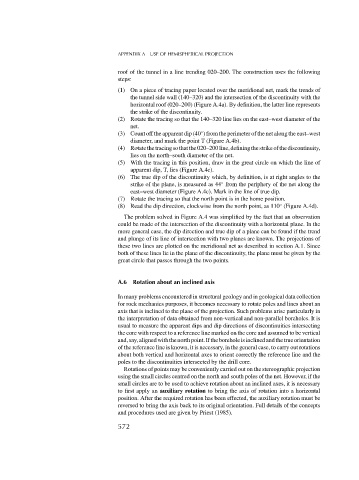Page 590 - Rock Mechanics For Underground Mining
P. 590
APPENDIX A USE OF HEMISPHERICAL PROJECTION
roof of the tunnel in a line trending 020–200. The construction uses the following
steps:
(1) On a piece of tracing paper located over the meridional net, mark the trends of
the tunnel side wall (140–320) and the intersection of the discontinuity with the
horizontal roof (020–200) (Figure A.4a). By definition, the latter line represents
the strike of the discontinuity.
(2) Rotate the tracing so that the 140–320 line lies on the east–west diameter of the
net.
(3) Count off the apparent dip (40 ) from the perimeter of the net along the east–west
◦
diameter, and mark the point T (Figure A.4b).
(4) Rotatethetracingsothatthe020–200line,definingthestrikeofthediscontinuity,
lies on the north–south diameter of the net.
(5) With the tracing in this position, draw in the great circle on which the line of
apparent dip, T, lies (Figure A.4c).
(6) The true dip of the discontinuity which, by definition, is at right angles to the
strike of the plane, is measured as 44 from the periphery of the net along the
◦
east–west diameter (Figure A.4c). Mark in the line of true dip.
(7) Rotate the tracing so that the north point is in the home position.
(8) Read the dip direction, clockwise from the north point, as 110 (Figure A.4d).
◦
The problem solved in Figure A.4 was simplified by the fact that an observation
could be made of the intersection of the discontinuity with a horizontal plane. In the
more general case, the dip direction and true dip of a plane can be found if the trend
and plunge of its line of intersection with two planes are known. The projections of
these two lines are plotted on the meridional net as described in section A.1. Since
both of these lines lie in the plane of the discontinuity, the plane must be given by the
great circle that passes through the two points.
A.6 Rotation about an inclined axis
In many problems encountered in structural geology and in geological data collection
for rock mechanics purposes, it becomes necessary to rotate poles and lines about an
axis that is inclined to the plane of the projection. Such problems arise particularly in
the interpretation of data obtained from non-vertical and non-parallel boreholes. It is
usual to measure the apparent dips and dip directions of discontinuities intersecting
the core with respect to a reference line marked on the core and assumed to be vertical
and,say,alignedwiththenorthpoint.Iftheboreholeisinclinedandthetrueorientation
of the reference line is known, it is necessary, in the general case, to carry out rotations
about both vertical and horizontal axes to orient correctly the reference line and the
poles to the discontinuities intersected by the drill core.
Rotations of points may be conveniently carried out on the stereographic projection
using the small circles centred on the north and south poles of the net. However, if the
small circles are to be used to achieve rotation about an inclined axes, it is necessary
to first apply an auxiliary rotation to bring the axis of rotation into a horizontal
position. After the required rotation has been effected, the auxiliary rotation must be
reversed to bring the axis back to its original orientation. Full details of the concepts
and procedures used are given by Priest (1985).
572

